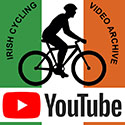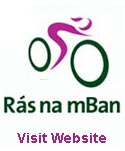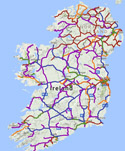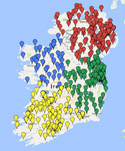There are a number of things that riders can do to improve safety while still being totally competitive. I realize that a lot of this may be very basic to some of the more experienced riders, however I think everyone can gain by addressing the safety issues.
TAKING PERSONAL RESPONSIBILITY:
This includes your behaviour during races, following the race rules, maintaining your bicycle in good condition and development of good technique for bunch riding.
THE BICYCLE:
Both brakes should work well and be adjusted close to the rim so that in emergency braking your brake lever does not go right into your bars when applied.
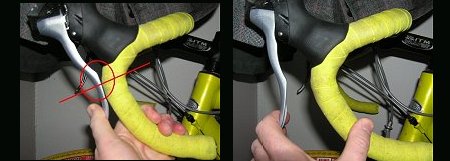
The RIGHT WAY and the WRONG WAY to have your brakes
|
Learn how to use both your brakes for emergency stops as well as general braking.
Gears should be well adjusted so that they are smooth on the sprockets and particularly that the chain does not jump on the sprockets, which can cause a fall.
The quick release on the wheels should be firmly adjusted.
Brake levers should be adjusted so that you can safely reach and apply them whether you are holding the drops or tops of the bars.
Note: how David Peelo and Colm Bracken two of Ireland's most successful and experienced riders have their handle bars and brake levers set up so that they can apply them whether their hands are on the drops of the bars or the brake levers. Coincidentally these two riders won two of the major races in the last two weekends.
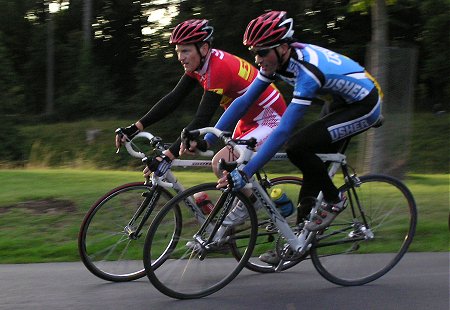
David Peelo and Colm Bracken cornering
|
All bicycle part should be tight and well adjusted. Regular checks should be part of your race preparation.
If you ride tubular tyres they should be well stuck on to the rim and regularly checked.
OTHER TRAFFIC:
Bear in mind that the roads are open. And even though most race organisers and the Gardai do a very good job warning and controlling oncoming traffic this is the biggest danger to your safety when racing.
No matter how good the race traffic control system there is always the possibility of a car straying accidentally into the race. For example a car coming out of a house after the marshals and race police have passed. The driver might not even be aware that there is a race on the road. Or the scenario that has happened with serious consequences for riders on a number of major races in Ireland, and other countries. This is where a driver is just impatient or stupid or a combination of both and ignores race marshals and drives on into the race.
Keep to the correct side of the road particularly on bends. This is where you are at your most vulnerable. You should take personal responsibility here and under no circumstances ride around blind bends on the wrong side of the road.
ANTICIPATE:
Especially because of the fact that we generally race on open roads riders should be anticipating what's happening further up the road at all times to allow for time to react to situations. This should save a lot of jamming on of brakes.
Call out for potholes parked cars etc and take evasive action with plenty of time to spare. This saves riders flicking around obstacles and riders behind them making contact with the pothole or car.
Obstructions - potholes etc:
When riding in a group anticipation and early evasive action is essential to avoid sudden unexpected changes in direction which are often the cause of accidents.
Clear signals and communication between riders is essential during events.
Examples

Diagram 'A'
|
A Good example of anticipation as the riders check behind to see that is safe to move out then gradually move out to avoid the parked car. This is a smooth action which if clearly signalled is very safe.

Diagram 'B'
|
This is a very dangerous manouvre as the riders are too close to the car before they move out to pass it and they must turn very sharply which can cause chaos in the group. This manouvre also puts the cyclist into danger from other cars etc which may be approaching or overtaking them.
When following wheels ride slightly to the side of the rear wheel that you are following to avoid hitting it if the rider in front of you freewheels or brakes.
RELAX:
When you want to move up in the bunch wait until its safe to do so. There is usually opportunity to do this when the road widens out etc.
Have a quick glance behind to see that it's safe to change direction and signal to other riders before you do change direction when riding in a group.
Ride in a straight line. This is particularly important in sprints where it's dangerous enough without people switching.
Look where you are going at all times. At the speed you travel when racing even taking your eyes off the road for a second can mean the difference between you missing a car door opening, a dog running out on to the road or someone stepping off a footpath.
Be generous with other riders when it comes to safety issues. Give way to let other riders move in or out when there are obstacles other traffic etc.
WHEN THE RACE IS FINISHED:
Be aware that there is race traffic and other cyclist's may be finishing seconds or minutes behind you so be careful before you either stop too close to the finishing line, if at all possible avoid doing a U turn to go back to the judges to find out where you might have finished in the race. Cooperate with the race organisers and help them to clear the finish area. They usually have enough to be doing at the finish without being distracted by riders who have finished. This is especially dangerous when a group of riders stop just beyond the finishing line and block following race cars, which then become a serious hazard to other riders sprinting in to the finishing line.
FINALLY:
--- BAN THE TERM "PUT THE HEAD DOWN AND RIDE" ---
This has exercised me for years since I nearly rode into an oncoming car during a time trial in my first year of racing.
I was riding with my head down, looked up and I was heading straight for the front of an oncoming speeding car.
Anyway I barely missed the car and when I recovered from the shock I was not so inclined to ride with my head down for the rest of my time cycling. I was one of the lucky ones that missed the car, over the years there have been quite a number of riders that rode into the back of cars or hit oncoming cars or dogs or even rode into policemen or barriers at Tour De France stage finishes as a consequence of riding with their head down.
The reason I was riding with my head down was because an experienced cyclist had told me to do so when I asked him how to ride time trials.
I am still shocked today when I sometimes hear people shouting at riders to get the head down when they are breaking away or in breakaways or time trials. If this is said to young or older inexperienced riders by people whom they perceive to be experienced people, that's exactly what they are likely do with serious risk to the rider's safety. It might be far better if they are instructed to look where you are going / keep your head up..
COMMISAIRES:
I believe Commisaires should penalise riders for persistent head down riding as it endangers the rider, other rider's safety and the integrity of the sport. I am sure this could be classified under dangerous riding. As this is near the beginning of the underage season perhaps a start could be made with educating the younger riders and the people who attend their races and having the sanction for use if really necessary. Let's have a safe season!
